UV-Blocking, Transparent, and Antioxidant Polycyanoacrylate Films
Abstract
:1. Introduction
2. Materials and Methods
2.1. Materials
2.2. Preparation of the Films
2.3. Attenuated Total Reflection Fourier Transform Infrared (ATR-FTIR) Spectroscopy
2.4. Scanning Electron Microscopy (SEM), Atomic Force Microscopy (AFM), and Optical Profilometry
2.5. Light Transmittance Analysis
2.6. Mechanical Characterization
2.7. Water Uptake and Film Hydrophobicity
2.8. Oxygen and Water Vapor Barrier Measurements
2.9. Antioxidant Effect Measurements
3. Results and Discussion
3.1. Morphological and Mechanical State of the Films
3.2. Chemical Characterization
3.3. UV-Blocking Characteristics
3.4. Hydrophobicity and Water Vapor Absorption
3.5. Water Vapor Barrier and Oxygen Gas Permeation
3.6. Antioxidant Release and Capacity
4. Conclusions
Supplementary Materials
Author Contributions
Funding
Acknowledgments
Conflicts of Interest
References
- Bayer, I.S. Nanostructured Cyanoacrylates: Biomedical Applications. In Smart Nanoparticles for Biomedicine; Elsevier: Amsterdam, The Netherlands, 2018; pp. 65–81. [Google Scholar]
- Mele, E.; Heredia-Guerrero, J.A.; Bayer, I.S.; Ciofani, G.; Genchi, G.G.; Ceseracciu, L.; Davis, A.; Papadopoulou, E.L.; Barthel, M.J.; Marini, L.; et al. Zwitterionic Nanofibers of Super-Glue for Transparent and Biocompatible Multi-Purpose Coatings. Sci. Rep. 2015, 5, 14019. [Google Scholar] [CrossRef] [Green Version]
- Liu, S.-L.; Long, Y.-Z.; Huang, Y.-Y.; Zhang, H.-D.; He, H.-W.; Sun, B.; Sui, Y.-Q.; Xia, L.-H. Solventless electrospinning of ultrathin polycyanoacrylate fibers. Polym. Chem. 2013, 4, 5696. [Google Scholar] [CrossRef]
- Masood, M.T.; Zahid, M.; Goldoni, L.; Ceseracciu, L.; Athanassiou, A.; Bayer, I.S. Highly Transparent Polyethylcyanoacrylates from Approved Eco-Friendly Fragrance Materials Demonstrating Excellent Fog-Harvesting and Anti-Wear Properties. ACS Appl. Mater. Interfaces 2018, 10, 34573–34584. [Google Scholar] [CrossRef] [PubMed]
- Yang, J.; Lee, H.; Hyung, W.; Park, S.-B.; Haam, S. Magnetic PECA nanoparticles as drug carriers for targeted delivery: Synthesis and release characteristics. J. Microencapsul. 2006, 23, 203–212. [Google Scholar] [CrossRef]
- Lin, X.; Zhou, R.; Qiao, Y.; Jin, F.; Zhai, Y.; Xing, J.; Deng, L.; Dong, A. Poly (ethylene glycol)/poly (ethyl cyanoacrylate) amphiphilic triblock copolymer nanoparticles as delivery vehicles for dexamethasone. J. Polym. Sci. Part A Polym. Chem. 2008, 46, 7809–7815. [Google Scholar] [CrossRef]
- Heng, P.W.S.; Chan, L.W.; Ong, K.T. Influence of storage conditions and type of plasticizers on ethylcellulose and acrylate films formed from aqueous dispersions. J. Pharm. Pharm. Sci. 2003, 6, 334–344. [Google Scholar]
- Jha, A.; Dutta, B.; Bhowmick, A.K. Effect of fillers and plasticizers on the performance of novel heat and oil-resistant thermoplastic elastomers from nylon-6 and acrylate rubber blends. J. Appl. Polym. Sci. 1999, 74, 1490–1501. [Google Scholar] [CrossRef]
- Tripodo, G.; Wischke, C.; Lendlein, A. Highly Flexible Poly(ethyl-2-cyanoacrylate) Based Materials Obtained by Incorporation of Oligo(ethylene glycol)diglycidylether. Macromol. Symp. 2011, 309–310, 49–58. [Google Scholar] [CrossRef]
- Paraskevopoulou, D.; Achilias, D.S.; Paraskevopoulou, A. Migration of styrene from plastic packaging based on polystyrene into food simulants. Polym. Int. 2012, 61, 141–148. [Google Scholar] [CrossRef]
- Enriquez, E.; Andrzejewski, J.; Misra, M. Biobased blends of poly(propylene carbonate) and poly(hydroxybutyrate-co-hydroxyvalerate): Fabrication and characterization. J. Appl. Polym. Sci. 2017, 134. [Google Scholar] [CrossRef]
- Ploypetchara, N.; Suppakul, P.; Atong, D.; Pechyen, C. Blend of Polypropylene/Poly(lactic acid) for Medical Packaging Application: Physicochemical, Thermal, Mechanical, and Barrier Properties. Energy Procedia 2014, 56, 201–210. [Google Scholar] [CrossRef] [Green Version]
- Yao, M.; Deng, H.; Mai, F.; Wang, K.; Zhang, Q.; Chen, F.; Fu, Q. Modification of poly(lactic acid)/poly(propylene carbonate) blends through melt compounding with maleic anhydride. Express Polym. Lett. 2011, 5, 937–949. [Google Scholar] [CrossRef]
- Luinstra, G.A.; Borchardt, E. Material Properties of Poly(Propylene Carbonates). In Synthetic Biodegradable Polymers; Rieger, B., Künkel, A., Coates, G.W., Reichardt, R., Dinjus, E., Zevaco, T.A., Eds.; Springer: Berlin/Heidelberg, Germany, 2011; Volume 245, pp. 29–48. [Google Scholar]
- Espíndola, K.M.M.; Ferreira, R.G.; Narvaez, L.E.M.; Rosario, A.C.R.S.; Da Silva, A.H.M.; Silva, A.G.B.; Vieira, A.P.O.; Monteiro, M.C. Chemical and Pharmacological Aspects of Caffeic Acid and Its Activity in Hepatocarcinoma. Front. Oncol. 2019, 9, 541. [Google Scholar] [CrossRef] [PubMed] [Green Version]
- Rezaei-Seresht, H.; Cheshomi, H.; Falanji, F.; Movahedi-Motlagh, F.; Hashemian, M.; Mireskandari, E. Cytotoxic activity of caffeic acid and gallic acid against MCF-7 human breast cancer cells: An in silico and in vitro study. Avicenna J. Phytomed. 2019, 9, 574–586. [Google Scholar] [PubMed]
- Kristinová, V.; Mozuraityte, R.; Storrø, I.; Rustad, T. Antioxidant Activity of Phenolic Acids in Lipid Oxidation Catalyzed by Different Prooxidants. J. Agric. Food Chem. 2009, 57, 10377–10385. [Google Scholar] [CrossRef]
- Nunes, C.; Maricato, É.; Cunha, Â.; Nunes, A.; Da Silva, J.L.; Coimbra, M.A. Chitosan–caffeic acid–genipin films presenting enhanced antioxidant activity and stability in acidic media. Carbohydr. Polym. 2013, 91, 236–243. [Google Scholar] [CrossRef]
- Yu, S.-H.; Hsieh, H.-Y.; Pang, J.-C.; Tang, D.-W.; Shih, C.-M.; Tsai, M.-L.; Tsai, Y.-C.; Mi, F.-L. Active films from water-soluble chitosan/cellulose composites incorporating releasable caffeic acid for inhibition of lipid oxidation in fish oil emulsions. Food Hydrocoll. 2013, 32, 9–19. [Google Scholar] [CrossRef]
- Benbettaïeb, N.; Nyagaya, J.; Seuvre, A.-M.; Debeaufort, F. Antioxidant Activity and Release Kinetics of Caffeic and p-Coumaric Acids from Hydrocolloid-Based Active Films for Healthy Packaged Food. J. Agric. Food Chem. 2018, 66, 6906–6916. [Google Scholar] [CrossRef]
- Akretche, H.; Pierre, G.; Moussaoui, R.; Michaud, P.; Delattre, C. Valorization of olive mill wastewater for the development of biobased polymer films with antioxidant properties using eco-friendly processes. Green Chem. 2019, 21, 3065–3073. [Google Scholar] [CrossRef]
- Choe, E.; Min, D.B. Mechanisms of Antioxidants in the Oxidation of Foods. Compr. Rev. Food Sci. Food Saf. 2009, 8, 345–358. [Google Scholar] [CrossRef]
- Wei, Z.; Cai, C.; Huang, Y.; Wang, P.; Song, J.; Deng, L.; Fu, Y. Strong biodegradable cellulose materials with improved crystallinity via hydrogen bonding tailoring strategy for UV blocking and antioxidant activity. Int. J. Boil. Macromol. 2020, 164, 27–36. [Google Scholar] [CrossRef] [PubMed]
- Zhao, L.; Ouyang, X.; Ma, G.; Qian, Y.; Qiu, X.; Ruan, T. Improving antioxidant activity of lignin by hydrogenolysis. Ind. Crop. Prod. 2018, 125, 228–235. [Google Scholar] [CrossRef]
- Tedeschi, G.; Guzman-Puyol, S.; Ceseracciu, L.; Paul, U.C.; Picone, P.; Di Carlo, M.; Athanassiou, A.; Heredia-Guerrero, J.A. Multifunctional Bioplastics Inspired by Wood Composition: Effect of Hydrolyzed Lignin Addition to Xylan–Cellulose Matrices. Biomacromolecules 2020, 21, 910–920. [Google Scholar] [CrossRef] [PubMed]
- Ma, Q.; Ren, Y.; Wang, L. Investigation of antioxidant activity and release kinetics of curcumin from tara gum/ polyvinyl alcohol active film. Food Hydrocoll. 2017, 70, 286–292. [Google Scholar] [CrossRef]
- De Dicastillo, C.L.; Alonso, J.M.; Catalá, R.; Gavara, R.; Hernández-Muñoz, P. Improving the Antioxidant Protection of Packaged Food by Incorporating Natural Flavonoids into Ethylene−Vinyl Alcohol Copolymer (EVOH) Films. J. Agric. Food Chem. 2010, 58, 10958–10964. [Google Scholar] [CrossRef] [PubMed]
- Guzman-Puyol, S.; Russo, D.; Penna, I.; Ceseracciu, L.; Palazon, F.; Scarpellini, A.; Cingolani, R.; Bertorelli, R.; Bayer, I.S.; Heredia-Guerrero, J.A.; et al. Facile production of seaweed-based biomaterials with antioxidant and anti-inflammatory activities. Algal Res. 2017, 27, 1–11. [Google Scholar] [CrossRef]
- Walheim, S.; Böltau, M.; Mlynek, J.; Krausch, G.; Steiner, U. Structure Formation via Polymer Demixing in Spin-Cast Films. Macroology 1997, 30, 4995–5003. [Google Scholar] [CrossRef]
- Böltau, M.; Walheim, S.; Mlynek, J.; Krausch, G.; Steiner, U. Surface-induced structure formation of polymer blends on patterned substrates. Nature 1998, 391, 877–879. [Google Scholar] [CrossRef]
- Howard, M.P.; Nikoubashman, A.; Panagiotopoulos, A.Z. Stratification in Drying Polymer–Polymer and Colloid–Polymer Mixtures. Langmuir 2017, 33, 11390–11398. [Google Scholar] [CrossRef]
- Ali, Z.; Le, H.H.; Ilisch, S.; Thurn-Albrecht, T.; Radusch, H.-J. Morphology development and compatibilization effect in nanoclay filled rubber blends. Polymer 2010, 51, 4580–4588. [Google Scholar] [CrossRef]
- Anastasiadis, S.H.; Gancarz, I.; Koberstein, J.T. Interfacial Tension of Immiscible Polymer Blends: Temperature and Molecular Weight Dependence. Macromolecules 1988, 21, 2980–2987. [Google Scholar] [CrossRef]
- Codou, A.; Anstey, A.; Misra, M.; Andrzejewski, J. Novel compatibilized nylon-based ternary blends with polypropylene and poly(lactic acid): Morphology evolution and rheological behaviour. RSC Adv. 2018, 8, 15709–15724. [Google Scholar] [CrossRef] [Green Version]
- Slouf, M.; Ostafinska, A.; Nevoralová, M.; Fortelny, I. Morphological analysis of polymer systems with broad particle size distribution. Polym. Test. 2015, 42, 8–16. [Google Scholar] [CrossRef]
- Sreenivasan, P.V.; Kurian, P. Mechanical Properties and Morphology of Nitrile Rubber Toughened Polystyrene. Int. J. Polym. Mater. 2007, 56, 1041–1050. [Google Scholar] [CrossRef]
- ElZein, T.; Nasser-Eddine, M.; Delaite, C.; Bistac, S.; Dumas, P. FTIR study of polycaprolactone chain organization at interfaces. J. Colloid Interface Sci. 2004, 273, 381–387. [Google Scholar] [CrossRef] [PubMed]
- Fei, B.; Chen, C.; Peng, S.; Zhao, X.; Wang, X.; Dong, L. FTIR study of poly(propylene carbonate)/bisphenol A blends. Polym. Int. 2004, 53, 2092–2098. [Google Scholar] [CrossRef]
- Pompeu, D.R.; Larondelle, Y.; Rogez, H.; Abbas, O.; Pierna, J.A.F.; Baeten, V. Characterization and discrimination of phenolic compounds using Fourier transform Raman spectroscopy and chemometric tools. Biotechnol. Agron. Soc. Environ. 2018, 22. [Google Scholar] [CrossRef]
- Tosovic, J.; Jelena, T. Spectroscopic features of caffeic acid: Theoretical study. Kragujev. J. Sci. 2017, 99–108. [Google Scholar] [CrossRef] [Green Version]
- Yuan, G.; Lv, H.; Yang, B.; Chen, X.; Sun, H. Physical Properties, Antioxidant and Antimicrobial Activity of Chitosan Films Containing Carvacrol and Pomegranate Peel Extract. Molecules 2015, 20, 11034–11045. [Google Scholar] [CrossRef] [Green Version]
- Ajitha, A.R.; Sabu, T.; Mostafapoor, F.; Khosravi, A.; Fereidoon, A.; Khalili, R.; Saeb, M. Compatibilization of Polymer Blends Micro and Nano Scale Phase Morphologies, Interphase Characterization and Properties; Elsevier: Amsterdam, The Netherlands, 2020. [Google Scholar]
- Prasad, N.R.; Jeyanthimala, K.; Ramachandran, S. Caffeic acid modulates ultraviolet radiation-B induced oxidative damage in human blood lymphocytes. J. Photochem. Photobiol. B Boil. 2009, 95, 196–203. [Google Scholar] [CrossRef]
- Wang, Y.; Su, J.; Li, T.; Ma, P.; Bai, H.; Xie, Y.; Chen, M.; Dong, W. A Novel UV-Shielding and Transparent Polymer Film: When Bioinspired Dopamine–Melanin Hollow Nanoparticles Join Polymers. ACS Appl. Mater. Interfaces 2017, 9, 36281–36289. [Google Scholar] [CrossRef] [PubMed]
- Ahmed, R. Optical study on poly (methyl methacrylate)/poly (vinyl acetate) blends. Int. J. Photoenergy 2009. [Google Scholar] [CrossRef]
- Hess, S.C.; Permatasari, F.A.; Fukazawa, H.; Schneider, E.M.; Balgis, R.; Ogi, T.; Okuyama, K.; Stark, W.J. Direct synthesis of carbon quantum dots in aqueous polymer solution: One-pot reaction and preparation of transparent UV-blocking films. J. Mater. Chem. A 2017, 5, 5187–5194. [Google Scholar] [CrossRef]
- Takahashi, S.; Okada, H.; Nobukawa, S.; Yamaguchi, M. Optical properties of polymer blends composed of poly(methyl methacrylate) and ethylene–vinyl acetate copolymer. Eur. Polym. J. 2012, 48, 974–980. [Google Scholar] [CrossRef]
- Zhang, W.; Gui, Z.; Lu, C.; Cheng, S.; Cai, D.; Gao, Y. Improving transparency of incompatible polymer blends by reactive compatibilization. Mater. Lett. 2013, 92, 68–70. [Google Scholar] [CrossRef]
- Maruhashi, Y.; Iida, S. Transparency of polymer blends. Polym. Eng. Sci. 2001, 41, 1987–1995. [Google Scholar] [CrossRef]
- Groeneveld, G.; Kuijer, S.; De Puit, M. Preparation of cyanoacrylate derivatives and comparison of dual action cyanoacrylate formulations. Sci. Justice 2014, 54, 42–48. [Google Scholar] [CrossRef]
- Wu, W.; Liu, T.; Deng, X.; Sun, Q.; Cao, X.; Feng, Y.; Wang, B.; Roy, V.A.L.; Li, R.K. Ecofriendly UV-protective films based on poly(propylene carbonate) biocomposites filled with TiO2 decorated lignin. Int. J. Boil. Macromol. 2019, 126, 1030–1036. [Google Scholar] [CrossRef]
- Mahmoud, B.H.; Ruvolo, E.; Hexsel, C.L.; Liu, Y.; Owen, M.R.; Kollias, N.; Lim, H.W.; Hamzavi, I.H. Impact of Long-Wavelength UVA and Visible Light on Melanocompetent Skin. J. Investig. Dermatol. 2010, 130, 2092–2097. [Google Scholar] [CrossRef] [Green Version]
- Zhang, Y.; Zhuang, S.; Xu, X.; Hu, J. Transparent and UV-shielding ZnO@PMMA nanocomposite films. Opt. Mater. 2013, 36, 169–172. [Google Scholar] [CrossRef]
- Godnjavec, J.; Znoj, B.; Veronovski, N.; Venturini, P. Polyhedral oligomeric silsesquioxanes as titanium dioxide surface modifiers for transparent acrylic UV blocking hybrid coating. Prog. Org. Coat. 2012, 74, 654–659. [Google Scholar] [CrossRef]
- Kainulainen, T.P.; Sirviö, J.A.; Sethi, J.; Hukka, T.I.; Heiskanen, J.P. UV-Blocking Synthetic Biopolymer from Biomass-Based Bifuran Diester and Ethylene Glycol. Macromolecules 2018, 51, 1822–1829. [Google Scholar] [CrossRef] [PubMed]
- Sirviö, J.A.; Visanko, M. Highly Transparent Nanocomposites Based on Poly(vinyl alcohol) and Sulfated UV-Absorbing Wood Nanofibers. Biomacromolecules 2019, 20, 2413–2420. [Google Scholar] [CrossRef]
- Rouhi, J.; Mahmud, S.; Naderi, N.; Ooi, C.H.R.; Mahmood, M.R. Physical properties of fish gelatin-based bio-nanocomposite films incorporated with ZnO nanorods. Nanoscale Res. Lett. 2013, 8, 364. [Google Scholar] [CrossRef] [PubMed] [Green Version]
- Khoirunnisa, A.R.; Joni, I.M.; Panatarani, C.; Rochima, E.; Praseptiangga, D. UV-screening, transparency and water barrier properties of semi refined iota carrageenan packaging film incorporated with ZnO nanoparticles. AIP Conf. Proc. 2018, 1927, 030041. [Google Scholar]
- Qian, Y.; Qiu, X.; Zhu, S. Lignin: A nature-inspired sun blocker for broad-spectrum sunscreens. Green Chem. 2015, 17, 320–324. [Google Scholar] [CrossRef]
- Khan, M.S.S.; Iqbal, M.A.; Majid, A.M.S.A. Effect of crystallization of caffeic acid enhanced stability and dual biological efficacy. Cogent Biol. 2016, 2, 1243460. [Google Scholar]
- Lai, S.-M.; Don, T.-M.; Huang, Y.-C. Preparation and properties of biodegradable thermoplastic starch/poly(hydroxy butyrate) blends. J. Appl. Polym. Sci. 2006, 100, 2371–2379. [Google Scholar] [CrossRef]
- Corre, Y.-M.; Bruzaud, S.; Grohens, Y. Poly(3-hydroxybutyrate-co -3-hydroxyvalerate) and Poly(propylene carbonate) Blends: An Efficient Method to Finely Adjust Properties of Functional Materials. Macromol. Mater. Eng. 2013, 298, 1176–1183. [Google Scholar] [CrossRef]
- Araghi, M.; Moslehi, Z.; Nafchi, A.M.; Mostahsan, A.; Salamat, N.; Garmakhany, A. Cold water fish gelatin modification by a natural phenolic cross-linker (ferulic acid and caffeic acid). Food Sci. Nutr. 2015, 3, 370–375. [Google Scholar] [CrossRef]
- Bastarrachea, L.J.; Dhawan, S.; Sablani, S.S. Engineering Properties of Polymeric-Based Antimicrobial Films for Food Packaging: A Review. Food Eng. Rev. 2011, 3, 79–93. [Google Scholar] [CrossRef]
- Sharmin, N.; Khan, R.A.; Salmieri, S.; Dussault, D.; Lacroix, M. Fabrication and Characterization of Biodegradable Composite Films Made of Using Poly(caprolactone) Reinforced with Chitosan. J. Polym. Environ. 2012, 20, 698–705. [Google Scholar] [CrossRef]
- Armentano, I. Processing and characterization of plasticized PLA/PHB blends for biodegradable multiphase systems. Express Polym. Lett. 2015, 9, 583–596. [Google Scholar] [CrossRef]
- Patwa, R.; Kumar, A.; Katiyar, V. Effect of silk nano-disc dispersion on mechanical, thermal, and barrier properties of poly(lactic acid) based bionanocomposites. J. Appl. Polym. Sci. 2018, 135, 46671. [Google Scholar] [CrossRef]
- Figueroa-Lopez, K.; Castro-Mayorga, J.; Andrade-Mahecha, M.M.; Cabedo, L.; Lagaron, J.M. Antibacterial and Barrier Properties of Gelatin Coated by Electrospun Polycaprolactone Ultrathin Fibers Containing Black Pepper Oleoresin of Interest in Active Food Biopackaging Applications. Nanomaterials 2018, 8, 199. [Google Scholar] [CrossRef] [Green Version]
- Rastogi, V.K.; Samyn, P. Bio-Based Coatings for Paper Applications. Coatings 2015, 5, 887–930. [Google Scholar] [CrossRef] [Green Version]
- Quilez-Molina, A.I.; Heredia-Guerrero, J.A.; Armirotti, A.; Paul, U.C.; Athanassiou, A.; Bayer, I.S. Comparison of physicochemical, mechanical and antioxidant properties of polyvinyl alcohol films containing green tealeaves waste extracts and discarded balsamic vinegar. Food Packag. Shelf Life 2020, 23, 100445. [Google Scholar] [CrossRef]
- Li, X.; Lin, J.; Gao, Y.; Han, W.; Chen, D. Antioxidant activity and mechanism of Rhizoma Cimicifugae. Chem. Cent. J. 2012, 6, 140. [Google Scholar] [CrossRef] [Green Version]
- Lee, J.H.; Yang, J.; Park, J.Y.; Lee, C.J.; Jang, N.K.; Shin, J.H.; Lim, D.-K.; Khang, G. Controlled release behavior and characterization of ropinirole hydrochloride using multi-layer formulation. J. Pharm. Investig. 2015, 45, 201–208. [Google Scholar] [CrossRef]
- Kang, N.J.; Lee, K.W.; Shin, B.J.; Jung, S.K.; Hwang, M.K.; Bode, A.M.; Heo, Y.-S.; Lee, H.J.; Dong, Z. Caffeic acid, a phenolic phytochemical in coffee, directly inhibits Fyn kinase activity and UVB-induced COX-2 expression. Carcinogenesis 2008, 30, 321–330. [Google Scholar] [CrossRef] [Green Version]
- Choi, I.; Lee, S.E.; Chang, Y.; Lacroix, M.; Han, J. Effect of oxidized phenolic compounds on cross-linking and properties of biodegradable active packaging film composed of turmeric and gelatin. LWT 2018, 93, 427–433. [Google Scholar] [CrossRef]
- Arrua, D.; Strumia, M.C.; Nazareno, M.A.; Arrua, R.D. Immobilization of Caffeic Acid on a Polypropylene Film: Synthesis and Antioxidant Properties. J. Agric. Food Chem. 2010, 58, 9228–9234. [Google Scholar] [CrossRef] [PubMed]

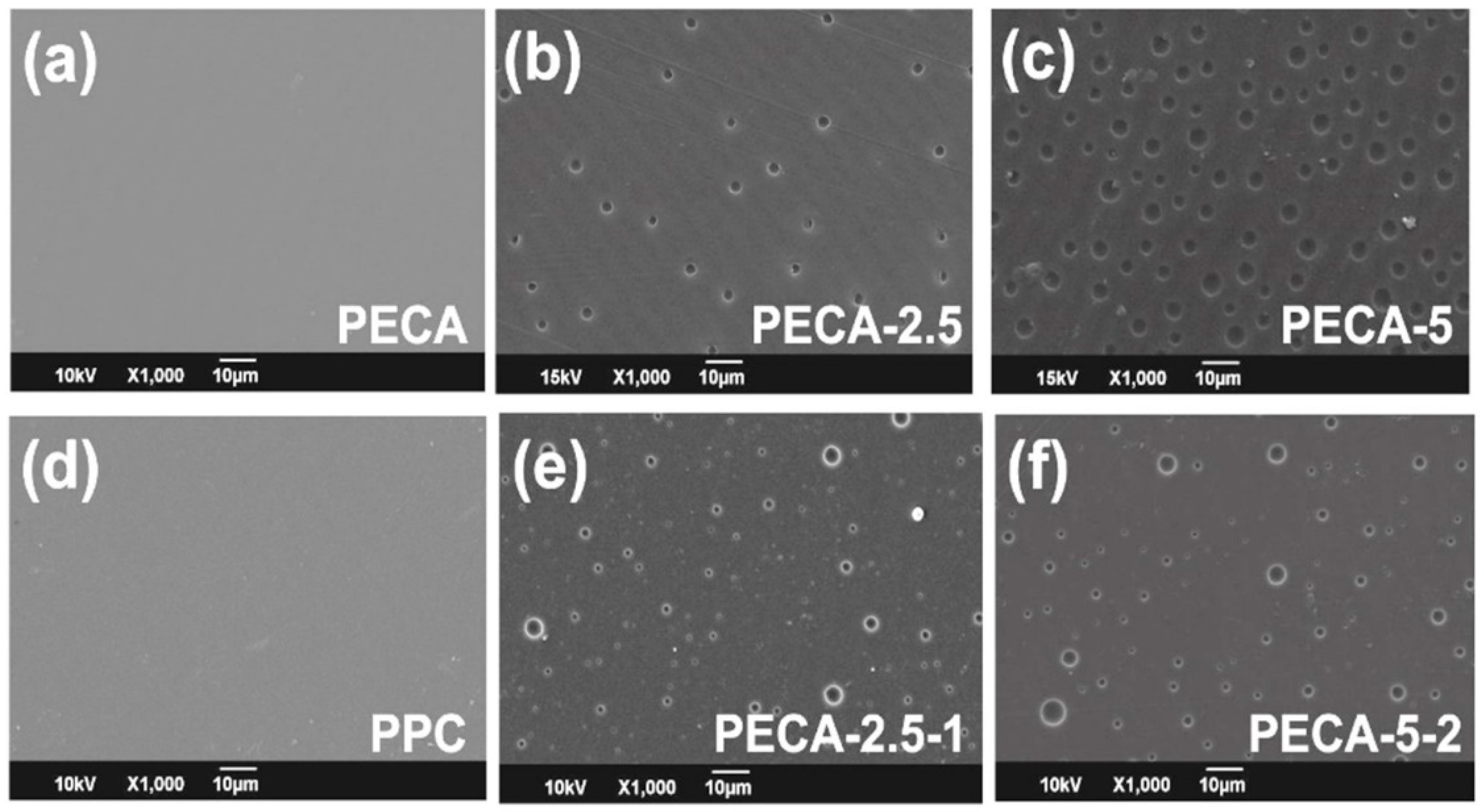
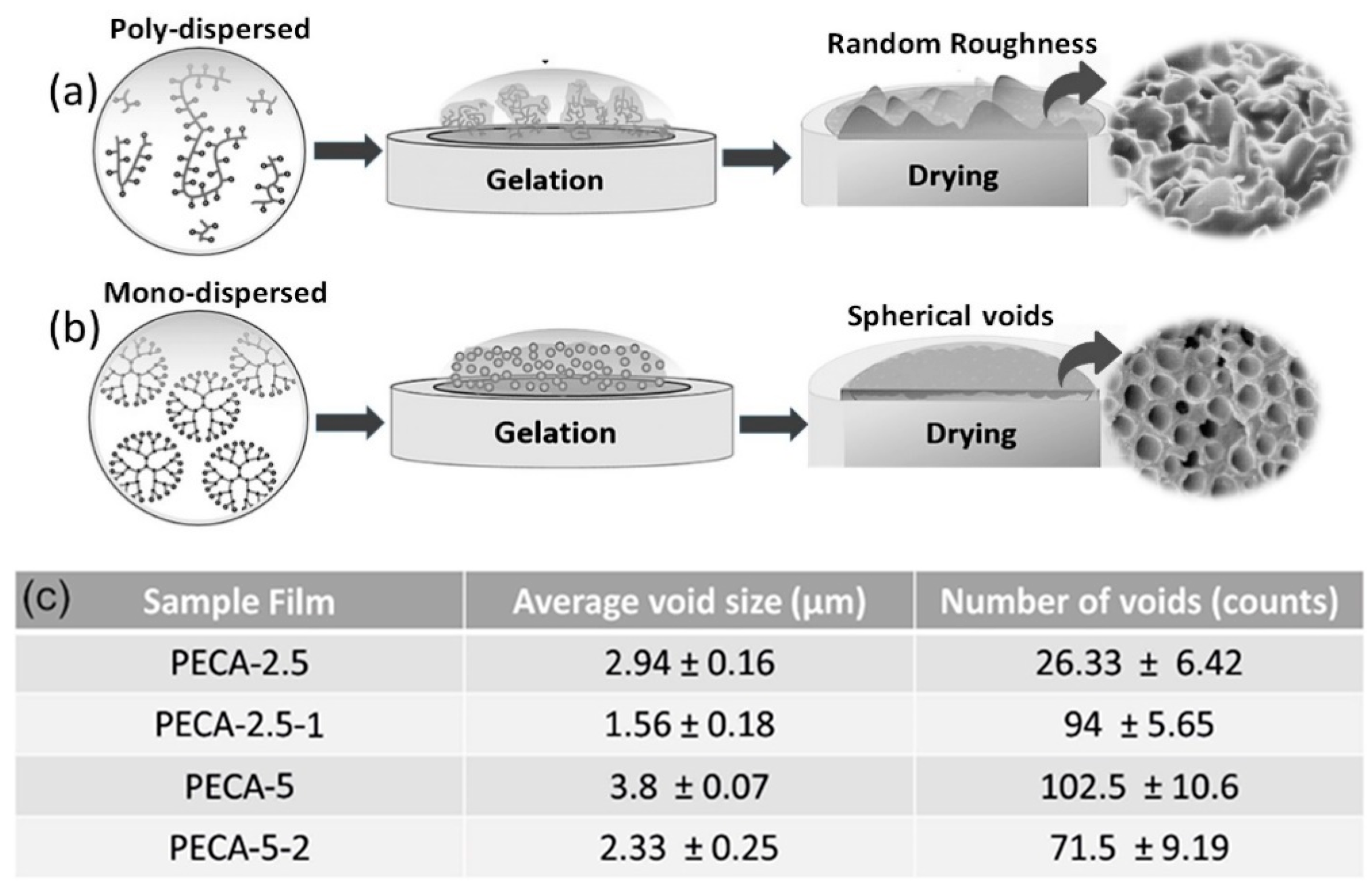
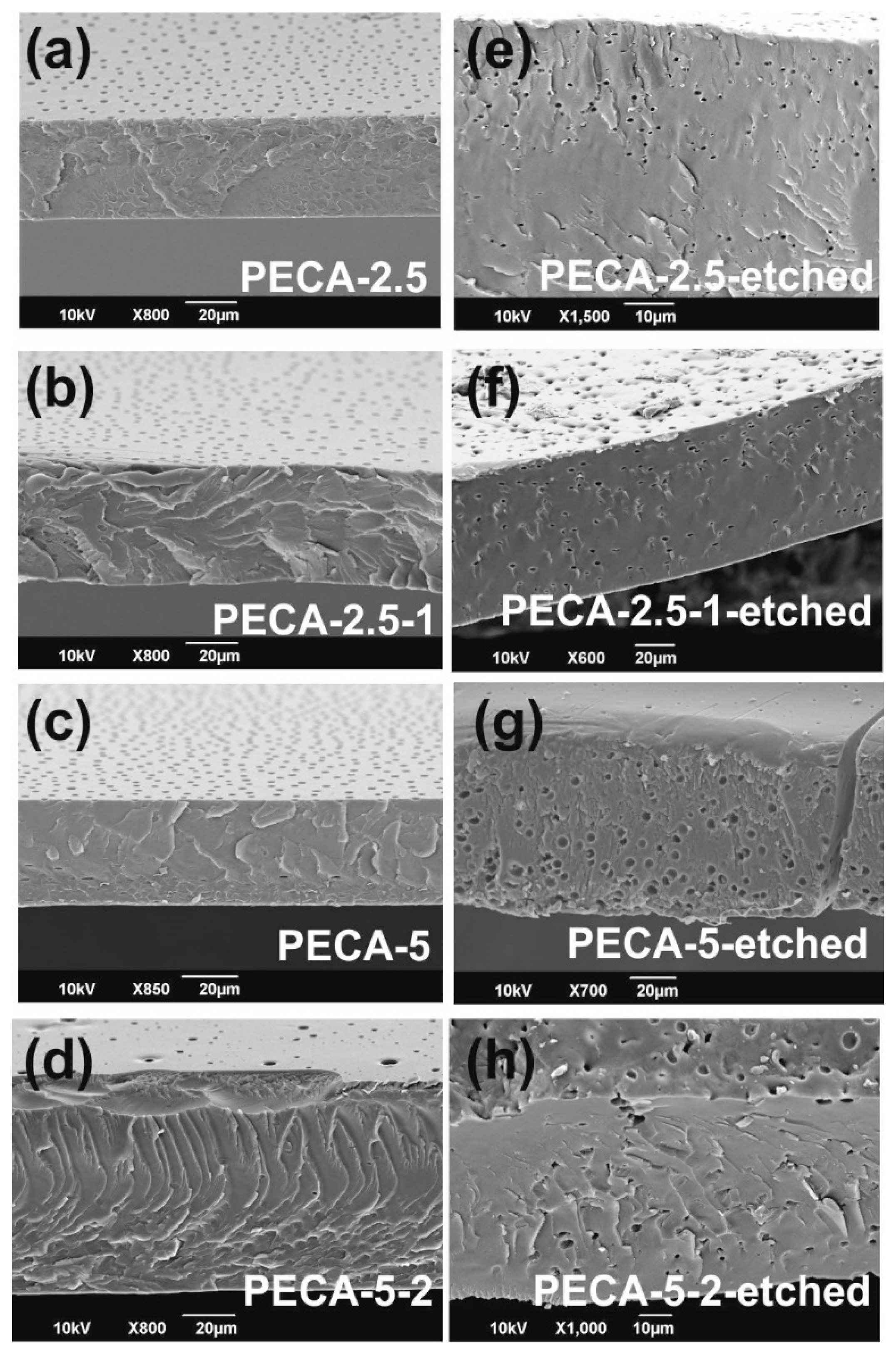
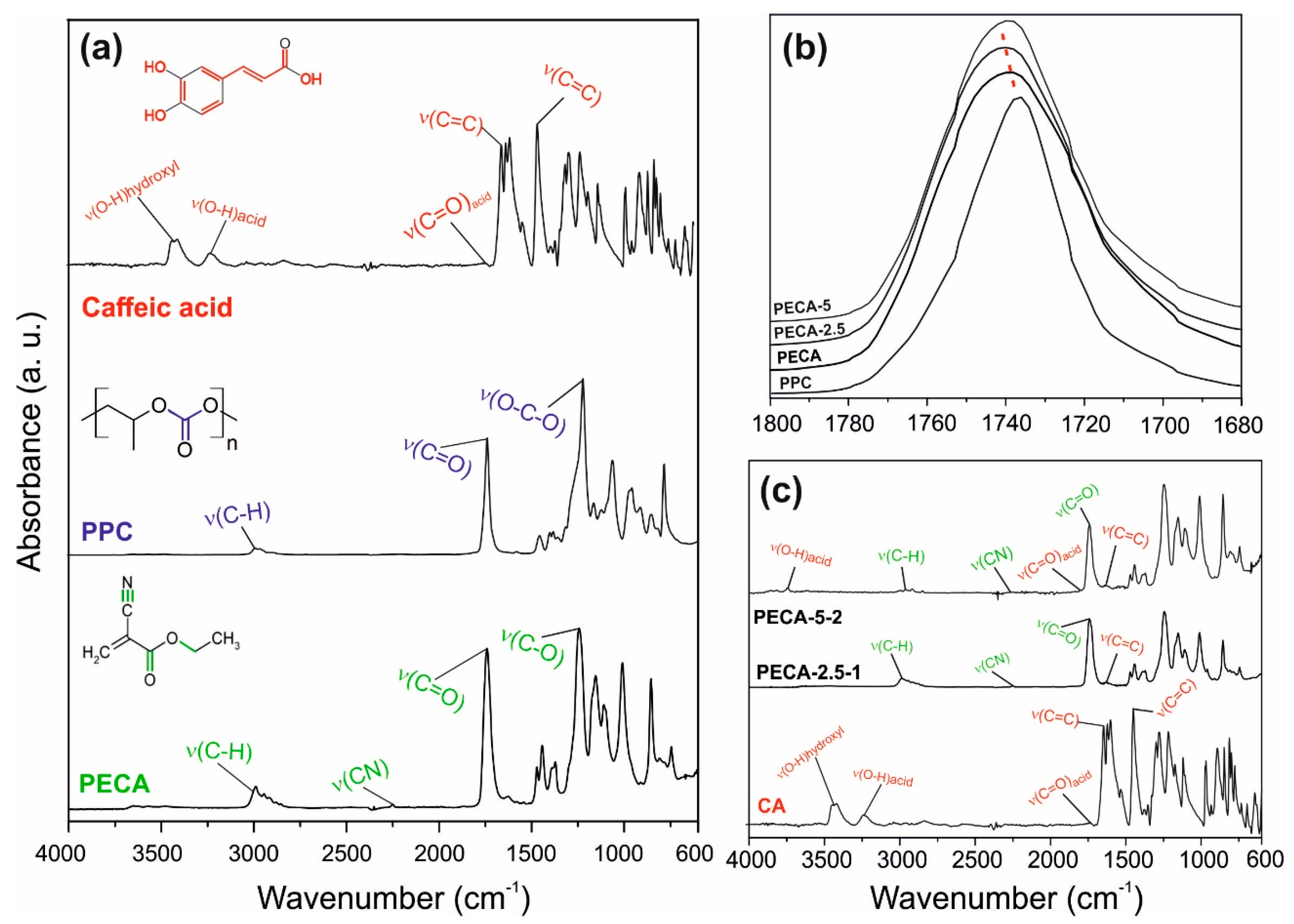
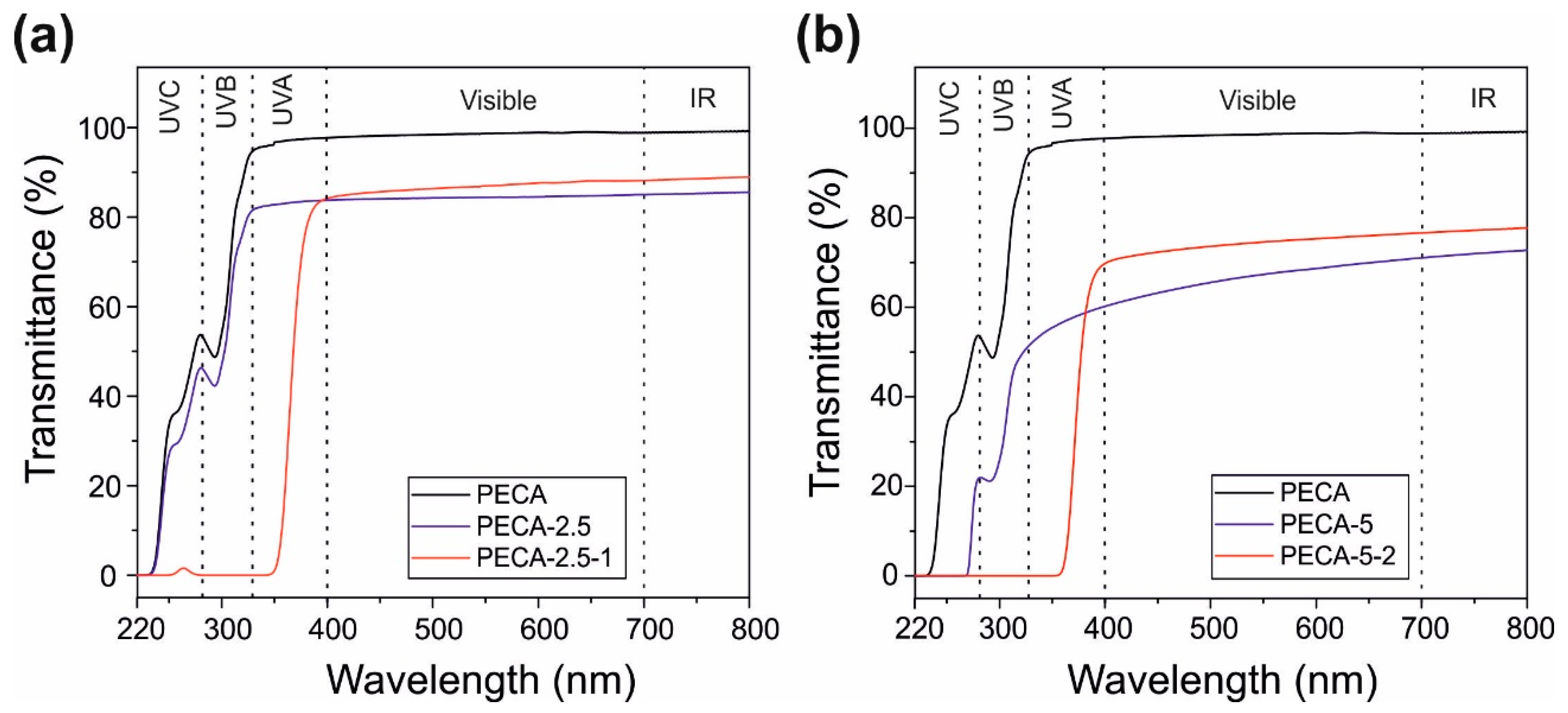

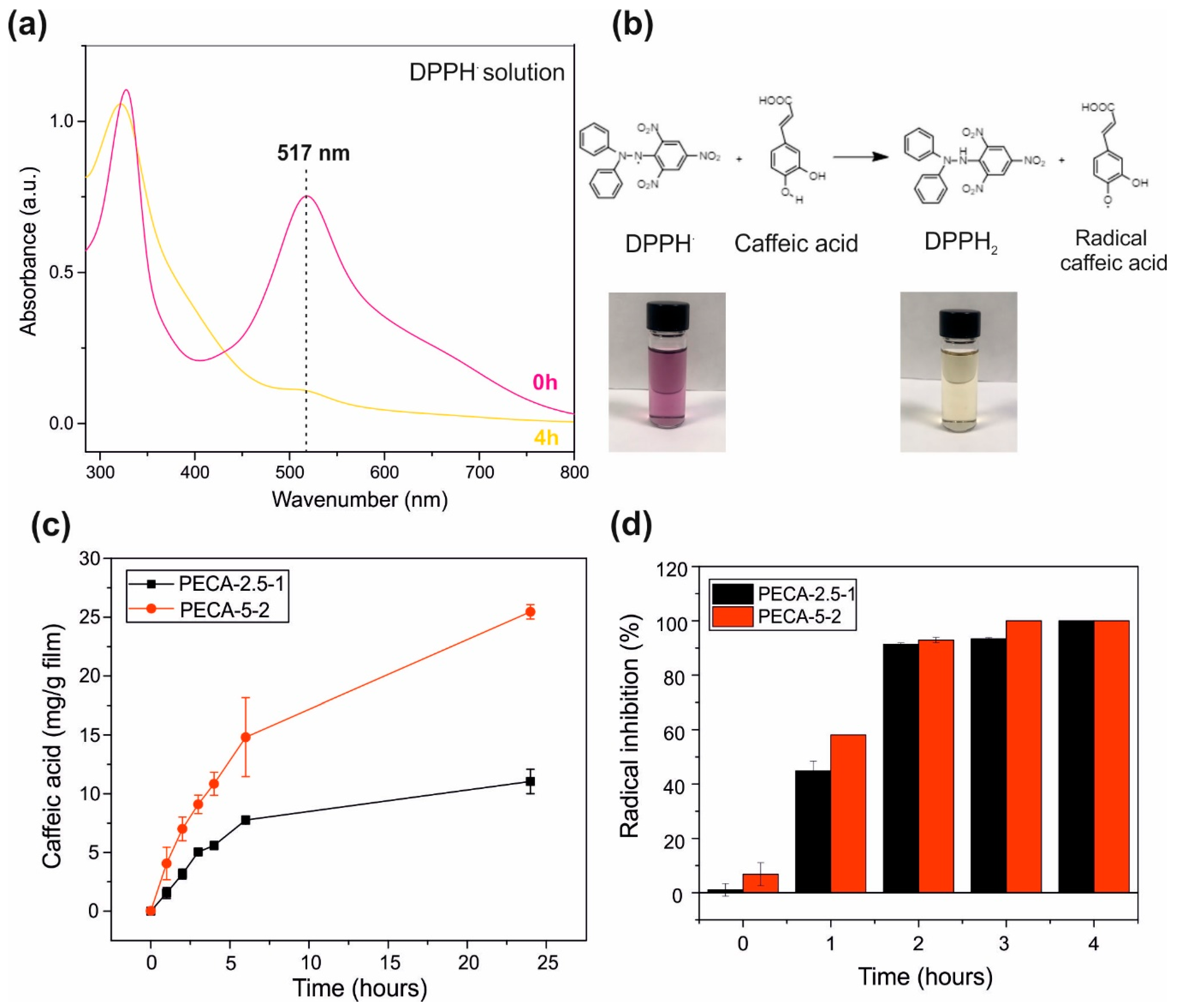
| Polymer Film | Concentration of PPC (wt.%) | Concentration of CA (wt.%) |
|---|---|---|
| PECA | - | - |
| PECA-2.5 | 2.5 | - |
| PECA-2.5-1 | 2.5 | 1.0 |
| PECA-5 | 5.0 | - |
| PECA-5-2 | 5.0 | 2.0 |
| Polymer | Additive | % Transmittance | Comments | Reference | ||
|---|---|---|---|---|---|---|
| UVC | UVB | UVA | ||||
| PVA | Dopamine−melanin Nanoparticles (NP) | 0 | 0 | 10–70% | Best performance: 5 vol.% NP | [44] |
| PVA | Carbon quantum dots | 0 | 10% | 5–60% | Best performance: 1 wt.% coating on PET | [46] |
| PMMA | ZnO quantum dots | 0 | 0 | 40–50% | Best performance: 0.05 wt.% ZnO | [53] |
| PMMA | ZnO quantum dots | 0 | 0 | 60% | Best performance: 2.4 wt.% ZnO | [53] |
| Waterborne acrylic | TiO2–Al2O3–POSS | 0 | 0 | 60% | Best performance: POSS | [54] |
| Bifuran polyester | Furan-Based Dicarboxylic Acids | 0 | 0 | 5% | Furan blocks UV | [55] |
| PVA | Wood nanofibers | 0 | 5–10% | 80% | Best Performance: 10 wt.% sulfated nanofibers | [56] |
| Fish Gelatin | ZnO nanorods | 0 | 0 | 3–15% | Best Performance: 5 wt.% ZnO | [57] |
| Carrageenan | ZnO nanoparticles | 5% | 5% | n/a | Best Performance: 5 wt.% ZnO | [58] |
| Sunscreen cream | Lignin | 15–45% | 20–60% | 25–80% | Best Performance: 10 wt.% Lignin | [59] |
| PPC | TiO2/lignin | 7–70% | 13–70% | 13–70% | Best Performance: 5 wt.% lignin-TiO2 | [51] |
| PECA–PPC | Caffeic acid | 0 | 0 | 17% | Best Performance: 2% caffeic acid | This study |
| Sample Film | Water Uptake (%) |
|---|---|
| PECA | 4.17 ± 0.89 |
| PPC | 2.6 ± 0.3 |
| PECA-2.5 | 3.02 ± 0.38 |
| PECA-2.5-1 | 6.95 ± 0.49 |
| PECA-5 | 4.31 ± 0.40 |
| PECA-5-2 | 8.78 ± 0.76 |
© 2020 by the authors. Licensee MDPI, Basel, Switzerland. This article is an open access article distributed under the terms and conditions of the Creative Commons Attribution (CC BY) license (http://creativecommons.org/licenses/by/4.0/).
Share and Cite
Quilez-Molina, A.I.; Marini, L.; Athanassiou, A.; Bayer, I.S. UV-Blocking, Transparent, and Antioxidant Polycyanoacrylate Films. Polymers 2020, 12, 2011. https://doi.org/10.3390/polym12092011
Quilez-Molina AI, Marini L, Athanassiou A, Bayer IS. UV-Blocking, Transparent, and Antioxidant Polycyanoacrylate Films. Polymers. 2020; 12(9):2011. https://doi.org/10.3390/polym12092011
Chicago/Turabian StyleQuilez-Molina, Ana Isabel, Lara Marini, Athanassia Athanassiou, and Ilker S. Bayer. 2020. "UV-Blocking, Transparent, and Antioxidant Polycyanoacrylate Films" Polymers 12, no. 9: 2011. https://doi.org/10.3390/polym12092011






